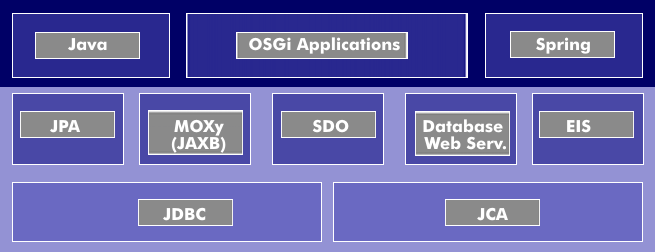EclipseLink
EclipseLink is the abbreviation for the Eclipse Persistence Services Project and specifically characterizes a persistence framework for Java applications. The framework is available as open source under the link below and supports various options for the realization of a Java persistence layer. EclipseLink is also called ORM framework(Object Relational Mapping) - objects are mapped to relational databases. However, this describes only a part of the possibilities of EclipseLink. Rather, the goal is to use not only relational databases but also systems that can be connected via XML or Java EE Connector Architecture (JCA) as data stores. For this purpose, EclipseLink relies on standards such as the Java Persistence API( JPA), the Java Architecture for XML Binding ( JAXB), Service Data Objects( SDO) and Open Services Gateway Initiative( OSGi).
The history of EclipseLink
EclipseLink is the reference implementation for the JPA. The project was started by the Eclipse Foundation after Oracle donated the source code of its successful persistence framework TopLink to the Eclipse community in 2007. This allowed the experience gained from TopLink, which was introduced as a commercial product for Java applications back in 1996, to be used. A first version of EclipseLink was released in June 2008, since December 2009 version 2.0 is available. Oracle naturally also has commercial interests in the project. For example, version 11g of TopLink is already based on EclipseLink and is freely available as an evaluation version. For productive use, TopLink then requires an appropriate licensing. The Spring framework also offers support for EclipseLink.
The figure summarizes the components and interfaces of EclipseLink in an overview.
The functionality of EclipseLink fundamentally distinguishes mapping metadata and the actual runtime environment. Through the metadata, Java objects and a number of specific persistence structures can be mapped to each other. Possible persistence structures are: Relational and object-relational databases, XML systems, and enterprise information systems. At the time of development, the metadata is based on native XML formats, which were created with the so-called workbench already known from Eclipse. Here this is adapted to the needs of EclipseLink and accompanies the entire development process. There are options for choosing the persistence structure, selecting the appropriate Java classes or defining the mapping structure separately, provided that classes and data are already available.
Use of EclipseLink in JPA implementations
The use of EclipseLink as a so-called JPA provider - that is, the definition of the concrete JPA implementation - is possible through any Java EE 5-compatible application server. However, the Eclipse Link project also provides detailed support for specific integrations for Oracle WebLogic, IBM WebSphere Application Server, Sun Application Server and JBoss. The application server GlashFish is already available since version 2.1 with EclipseLink as JPA provider.
With the integration of EclipseLink, a number of extensions to the Java Persistence API are available. These are addressed either through the choice of persistence unit properties or directly through supplementary mapping annotations. These include, in particular, extended mapping capabilities, optimistic and pessimistic locking, query hints, object- level caching including distributed caches as well as their coordination, performance enhancement capabilities, and extended Oracle database support.
For the details, an Eclipse link wiki is available for review at the link below.
Compared to other ORM frameworks, EclipseLink offers the following special features:
- It uses a level-2 cache that is cross-transactional. This caches used objects so that objects do not have to be created repeatedly.
- A shared pool of read connections to the database. Exclusive commits are requested only for the commit of a transaction. The result is high scaling when accessing the database.

